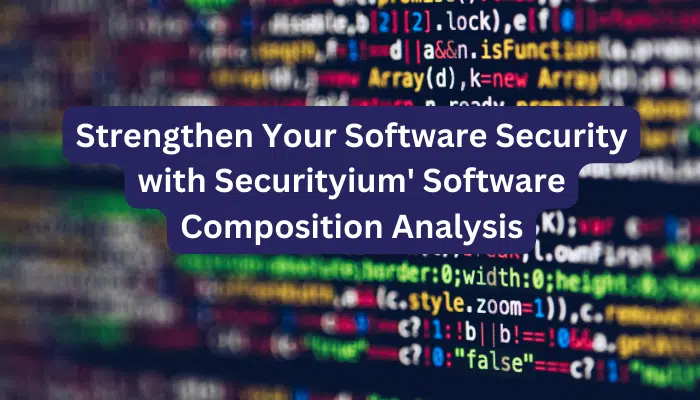
May 31, 2024 Information hub
Strengthen Software Security with SCA
Enhance your software security and ensure compliance with Securityium’s Software Composition Analysis (SCA) services. Identify and address security flaws, licensing compliance issues, and code quality concerns related to open source software. Our standardized methodology, including open-source detection, component identification, risk analysis, and false positive removal, provides comprehensive insights for businesses seeking robust application security. Safeguard your software, mitigate risks, and optimize your development processes with our expert security consultants.
In today’s rapidly evolving digital landscape, businesses rely heavily on software development to drive innovation and deliver exceptional user experiences. As the adoption of open source components continues to surge, it is crucial for organizations to ensure the safety and compliance of their software applications. That’s where Software Composition Analysis (SCA) steps in. At Securityium, we offer a comprehensive SCA methodology that empowers businesses to harness the benefits of open source software while mitigating security risks and regulatory challenges.
Understanding Software Composition Analysis: Software Composition Analysis enables developers to leverage open source software packages safely, without exposing their business to unnecessary security flaws or compliance issues. With modern software development heavily relying on open source components, it becomes crucial to identify and analyze these components for security vulnerabilities, licensing compliance, and code quality.
Our Standardized Methodology for Application Security Testing: At Securityium, we have devised a standardized methodology that covers a wide range of checks to ensure the utmost security and compliance in software applications. Let’s take a closer look at some of the key checks provided by our Software Composition Analysis:
Open-Source Detection: Our SCA methodology employs various detection methods to identify open-source components within your codebase. These methods include signature scanning, package manager inspection, build dependency analysis, and snippet scanning. By utilizing these techniques, we leave no stone unturned in identifying and assessing open source components used in your applications.
Component Identification: Once the open source components are detected, our SCA solution matches them against a comprehensive database maintained by our expert team. This database includes information from various reputable sources such as GitHub, Maven Central, and more. We understand the importance of minimizing false positives and ensuring accurate identification of components to provide you with reliable results.
Inherited Security Risk Analysis: After identification, our SCA solution generates associated risk metrics, allowing you to prioritize and focus your efforts effectively. By cross-referencing component versions with vulnerability and license databases, we provide valuable insights into potential security risks and licensing compliance issues. Our standardized scoring system, such as CVSS2.0 or CVSS3.0, helps you gauge the severity of each risk and make informed decisions.
License Risks Analysis: Ensuring compliance with software licenses is paramount. Our SCA methodology offers a comprehensive analysis of license risks tailored to your specific deployment scenario. We consider factors such as internal/external applications, commercial/non-commercial usage, and potential conflicts between permissive and reciprocal licenses. By understanding your license risks, we help you avoid any legal or financial ramifications.
Removal of False Positives: Our dedicated security testers meticulously examine all potential vulnerabilities flagged by automated scanners. Through rigorous manual testing and the use of different scripts, we verify the exploitability of each vulnerability, eliminating false positives. This step ensures that the findings we present to you are accurate, reliable, and actionable.
Conclusion: In today’s security-conscious landscape, businesses must proactively address software vulnerabilities and ensure compliance with licensing requirements. With Securityium’s Software Composition Analysis methodology, you can confidently embrace the power of open source components while safeguarding your applications against potential risks. Our comprehensive approach, coupled with expert analysis and actionable recommendations, empowers you to strengthen your software security posture and drive your business forward with confidence.
Choose Securityium for a comprehensive Software Composition Analysis that puts your software’s security and compliance at the forefront. Contact us today to get started on your journey toward robust application security.
